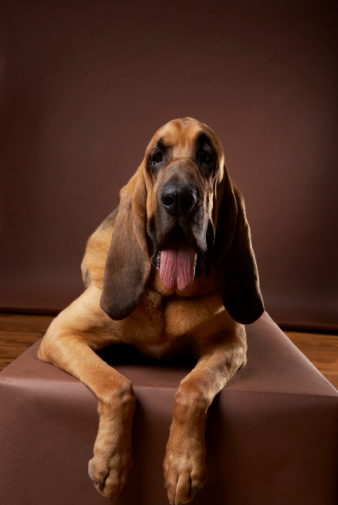Border Collie The Border Collie is also known as: None
Fast Facts
Group classification: Herding
Country of origin: Scotland and England
Date of origin: 19th century
Weight (M): 35 - 45 lb Height (M): 20 - 23"
Weight (M): 35 - 45 lb Height (M): 20 - 23"
Life expectancy: 11 - 14 years
Weight (F): 30 - 40 lb
Weight (F): 30 - 40 lb
Height (F): 18 - 21"
General Description of the Border Collie
The Border Collie is a medium size dog renowned for its unique herding techniques. The head is well proportioned, with a muzzle that tapers slightly toward the nose. Eyes are wide set, medium in size and oval shaped – color is typically brown but may be blue in merle dogs. Ears are set apart and carried erect or semi-erect; it is common to see one ear erect and the other semi-erect in some dogs. The Border Collie’s expression is intelligent and interested. The body is substantially muscular and facilitates graceful, fluid movement. The topline is level with an arch over the loin. The tail is set and carried low. The Border Collie’s coat is either rough or smooth, but in either case constitutes a soft, dense undercoat protected by a coarse, weather resistant outer coat. Coloring can be just about anything, including, solid, tricolor, bicolor, sable and merle.
Border Collie Temperament
The Border Collie is an uncannily intelligent dog with a natural inclination toward work and herding things in general, be it sheep, cars, or other animals. It is an alert, diligent and highly energetic dog. The Border Collie is also very responsive and easily trained. The dog has a good habit of remembering orders even when its master is out of sight, and requires minimal supervision when working. While reserved in the face of strangers, the Border Collie can be quite affectionate towards those it recognizes and is comfortable around. The dog’s characteristic stare during work and play can be quite endearing for its family, but may be disturbing for other animals. Border Collies have a reputation for not getting along well with small animals, though they are usually pretty good with dogs. This dog is protective of its family.
Caring for a Border Collie
If you can’t give the Border Collie a job to do, then at least make sure you can devote at least 45 minutes a day to providing it with exhausting, vigorous exercise. A game in the park or a challenging obedience training session is preferred. Proper socialization around cats and strangers, and to a lesser extent other dogs, is important and should begin at a young age. The Border Collie can live outside in moderate climates, but is infinitely happier when allowed to sleep indoors with its family. The Border Collie is not suited to living in an apartment, and needs ready access to a yard. Coat care involves a biweekly brushing session. The Border Collie is susceptible to canine hip dysplasia, and on rare occasions may develop diseases such as progressive retinal atrophy, CEA, seizures, lens luxation, PDA, OCD and deafness.
General Description of the Border Collie
The Border Collie is a medium size dog renowned for its unique herding techniques. The head is well proportioned, with a muzzle that tapers slightly toward the nose. Eyes are wide set, medium in size and oval shaped – color is typically brown but may be blue in merle dogs. Ears are set apart and carried erect or semi-erect; it is common to see one ear erect and the other semi-erect in some dogs. The Border Collie’s expression is intelligent and interested. The body is substantially muscular and facilitates graceful, fluid movement. The topline is level with an arch over the loin. The tail is set and carried low. The Border Collie’s coat is either rough or smooth, but in either case constitutes a soft, dense undercoat protected by a coarse, weather resistant outer coat. Coloring can be just about anything, including, solid, tricolor, bicolor, sable and merle.
Border Collie Temperament
The Border Collie is an uncannily intelligent dog with a natural inclination toward work and herding things in general, be it sheep, cars, or other animals. It is an alert, diligent and highly energetic dog. The Border Collie is also very responsive and easily trained. The dog has a good habit of remembering orders even when its master is out of sight, and requires minimal supervision when working. While reserved in the face of strangers, the Border Collie can be quite affectionate towards those it recognizes and is comfortable around. The dog’s characteristic stare during work and play can be quite endearing for its family, but may be disturbing for other animals. Border Collies have a reputation for not getting along well with small animals, though they are usually pretty good with dogs. This dog is protective of its family.
Caring for a Border Collie
If you can’t give the Border Collie a job to do, then at least make sure you can devote at least 45 minutes a day to providing it with exhausting, vigorous exercise. A game in the park or a challenging obedience training session is preferred. Proper socialization around cats and strangers, and to a lesser extent other dogs, is important and should begin at a young age. The Border Collie can live outside in moderate climates, but is infinitely happier when allowed to sleep indoors with its family. The Border Collie is not suited to living in an apartment, and needs ready access to a yard. Coat care involves a biweekly brushing session. The Border Collie is susceptible to canine hip dysplasia, and on rare occasions may develop diseases such as progressive retinal atrophy, CEA, seizures, lens luxation, PDA, OCD and deafness.































































